Research on headache and pain of jaw, in Spain
Tuesday, September 30, 2014
Measure and assess the headache and jaw to improve diagnosis and treatment is possible through a new tool to assess the symptoms, developed by a team of researchers, from the UNED, several universities and the Universitary Hospital “La Paz”(Madrid, Spain).

The instrument, called Craniofacial Pain and Disability Inventory (CF-PDI) is a questionnaire, which will improve diagnosis, in patients with primary and secondary headaches, as well as in those with temporomandibular disorders or other orofacial pain, as recorded by the UNED.
And the headaches and pain of jaw are very common symptoms, that have recently had about 60% of the population.
Although the relationship among the two conditions is known, the underlying mechanisms remain under investigation. The questionnaire was designed, in order to measure these ailments and disability, associated with them on one hand, and on the other hand, the functional status of the jaw.
"Pain is assessed by clinical diagnosis and in some cases by radiological tests", said the Dean of Physiotherapy in USSC La Salle and leader of the research group, Roy La Touche.
The researcher said that this method will continue getting so well; but it was necessary to have a Spanish instrument, to quantify "valid and reliable" pain and associated disability.
"This instrument is to play a key role, because it can help improve the specificity of diagnosis, patient monitoring and therapeutic interventions, that are planned", has topped La Touche.
The implementation and use of this tool does not imply a change in the way to diagnose headcephalic pain, but it helps to improve this practice.
The study, published in the journal Pain Physician, was made from a sample of 192 patients, from the University Hospital of La Paz, whom the questionnaire was administered.
They had chronic migraine, chronic tension headache, orofacial pain and temporomandibular disorders. Then, a psychometric analysis from the responses was performed. The result allowed to validate the CF-PDI, as an objective measurement tool, in these cases.
"The next step is to investigate more advanced psychometric properties and further analyze the behavior of inventory, using any therapeutic application, in clinical trials", concluded the member of the Department of Methodology of Behavioral Sciences of the UNED, Juan Carlos Suarez.
The study involved several institutions, in collaboration with members of the Research Group on Movement Sciences, Bioconduct Study of Pain and the Faculty of Health Sciences of the USSC La Salle.
One more time there is a very interesting Spanish research, that will give any hope to many patiens, all over the world. And I celebrate it.
Until my next post, kind regards,
Luis.
Sponsored by Costaluz Lawyers.
Please click below:

 0
Like
Published at 5:40 PM Comments (0)
0
Like
Published at 5:40 PM Comments (0)
The longest river in Europe, in Spain
Saturday, September 27, 2014
Yes, In Spain!!!. Incredible. I did not know it and when I read the news, a few days ago, I was surprised.
At 20 kilometers from Castellon, specifically in La Vall d´Uixó (East of Spain), you can visit the longest navigable underground river in Europe. Visitors can tour, in groups of 14 people, 1250 meters on boat and 350 meters more, walking on dry gallery.
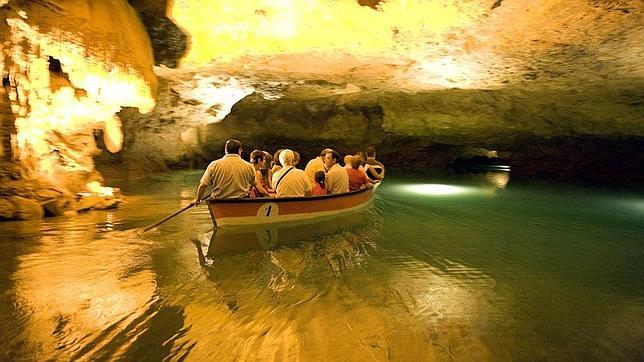
The cave has stalactites, over 30,000 years, and it is open, to public, since the 50s. Javier Paulo, Director of the site (the Site of San José), said, on the radio, he is considering starting 1,500m speleoturistic adventure route.
Despite having more than 60 years, as a touristic attraction, the origin of the river is yet to be discovered.
The cave has, inside, a constant temperature of 20 degrees Celsius all year.
This cave has enough history, because it was known in the Upper Paleolithic (17,000 years ago, more or less); this has been demonstrated with the archaeological deposits, found in the entrance, next to the cave paintings of the Magdalenian period.
There are some evidence, from the nineteenth century, about the habit of focusing the neighbors around "The spring of San José", due to the celebration of the "Feast of Flowers", where it was common for the most daring come into the cave. However, it was not until 1902, when the first known exploration was performed, reaching the "Entrance of the Forn" (one narrow passage, which through the small space, left by the water at that time, marked the limit of the accessible part of the cave).
During the following years it was growing the interest in knowing in detail the cave, and in 1915 the historian, Carlos Sarthou Carreres, made a partial exploration. In 1926, a group of neighbors passed the "Entrance of the Forn" and reached the "Diana Lake", finding as a insurmountable obstacle, the "Gallery of Siphons".
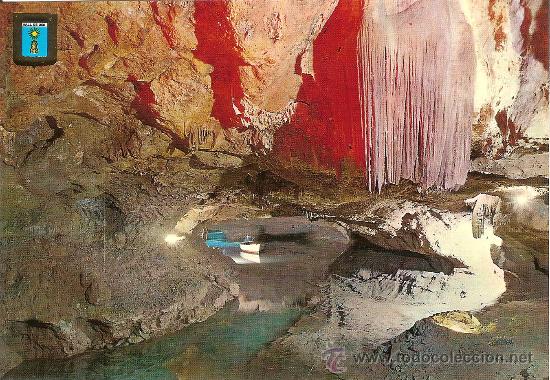
The Diana lake, Cave of San Jose
In 1929, Herminio Arroyas Martinez dies; he was a resident of the town to try to overcome the "Gallery of Siphons". In these years begin the first attempts to put the cave to facilitate visits, by installing walkways, and from 1936-1950, the development works start with dredging and construction of a dam, so in 1950, "The entrance of the Forn" is not the longer limit of travel, and through holes, were enlarged to allow passage of boats.
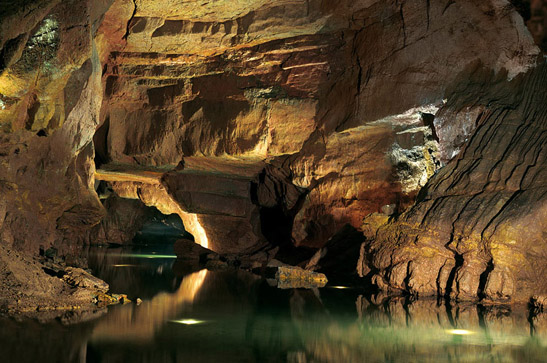
"Gallery of Siphons", Vall d´Uixó, Castellón
The first exploration, by a group of cavers, was conducted, in 1954, by the Traveller Centre of Valencia and, in 1958, the group manufactures the first topographical map of the cave. In 1960, the continuity of the cave is found, when Joaquín Saludes, from the Centre for Research and Underwater Activities of Valencia, exceeded the "Gallery of Siphons".
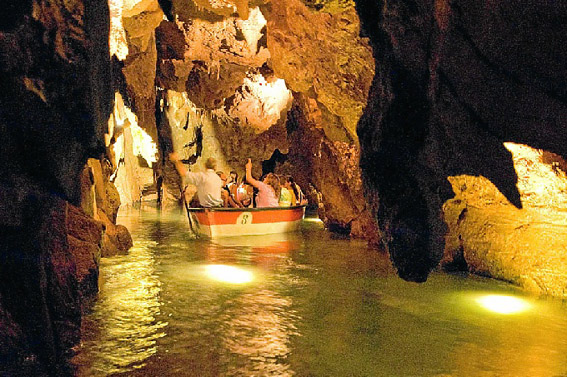
A gallery, going to the "dry gallery"
Blasting with dynamite allow this step to open in 1961. leaving bare the "Blue Pond" and the rest of the galleries, that make up the current tour, also discovered the "Dry Gallery".
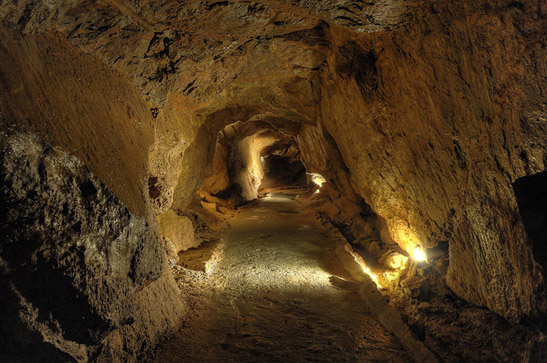
"The Dry gallery"
In subsequent years (1971-1975), various expeditions of cavers, from Castellón, and divers, from Barcelona, end up discovering new galleries and siphons, having gone to the known end of the cavity, reaching 2,348 meters.
Well, I hope that you can come to Spain, in order to visit this incredible cave.
Untill my next post, kind regards,
Luis.
Sponsored by Costaluz Lawyers.
Please click below:

 0
Like
Published at 12:10 AM Comments (1)
0
Like
Published at 12:10 AM Comments (1)
The perigee of the Moon from Spain
Tuesday, September 23, 2014
Last week we have seen, from Spain, the "perigee of the Moon"; ie, the shortest distance among the Moon and the Earth. So, we have seen the Moon much larger than other times, when there was a full moon. And it has been called "Supermoon". It also happened for a few days, in the first half of July.
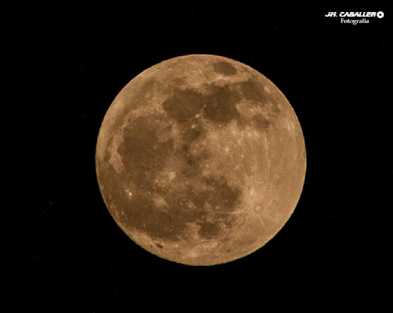
To Romans, there was the Moon Goddess (Luna); for Greeks, was Selene, who was the sister of Helios (the Sun God) and Eos (Goddess of Dawn). Helios means: “Who sees everything”. It is said that he drived a carriage, through the sky to the Ocean, every day, surrounding the earth, from the east to put itself in the west, at night. And it was the moment of Luna (Moon), who was represented by a beautiful woman , pale face, driving a silver chariot, drawn by a yoke of white oxen.
In Classical Mythology, there is a nice myth, related to the Moon. This myth says that Endymion (a shepherd of Caria and grandson of Zeus) fell in love with Selene. Then, he asked Anthems (the god of sleep) being able to sleep, with open eyes, to look at the Moon, when she was crossing with her carriage, the night sky. And the god Hymns, who was in love with this shepherd, gave him the desire to sleep with their open eyes, because Hymns wanted to see his eyes, during the night.
Some days ago, we have seen, very well, both from Spain and from other countries, the full moon, because it was in its "Perigee". It comes from the Greek "Peri - geo" ("around the Earth"). The Perigee is the point at which a star in its orbital motion, is closer to the Earth. And we use the word contrary, when the star reaches the farthest point in its orbit; it is said the same thing, when someone goes far, that it has succeeded in its life, we say that person is in full swing (ogee). Here we see the Greek root "apo", that means "lejos" (Apogeo = Apogee); then, "Apogee" means: "when it is far, higest".
These days we have been in “full (llena) moon”, “full (plena) moon”, his double: full (llena) and full (plena, booming); from there comes "Plenilunio" (Plenilunio is not very used; we use to say “Luna llena” (“Full moon”).
When meeting the Moon in its nearest point to Earth, the attraction of the moon is greater than the rest of the year. So, a few weeks ago, we have watched, on TV, some high tides, "spring tides" --also called "perigee tides"--.The Romans knew this fact (about the spring tides) and, for centuries, they used the Lunar Calendar and attributed to the Moon, certain odd behaviors, crimes, etc. People who were suffering madeness, occasionally, when there was a full moon, they were called “Lunaticos” (“Lunatics”).
The day of the Moon is “Lunae dies” and from it comes: “Lunes” and, in English “Monday”, that is like Moon, but only with an “o”; so, it should be “Moon – day”.
The Moon was the measure of time in antiquity. In Latin, we have the word "Mensis", which means moon, first, and then “Mes” ("Month"); and from there it comes “Mensual” ("Monthly"). Mensis refers to the temporal dimension of the Moon. However, the word Moon refers to its physical dimension, its appearance.
The Moon has the same root than Lux, Lucis (in Latin) (Luz = Light); the verb Lucere (Lucir = Shine); the noun Lumbre (Fire). All of them, with the same Indo-European root “Leu”, from where comes “Leucocito” (Leukocyte). Therefore, originally, Moon means “Which is illuminated”, “Which shines”.
Well, that is all about the Moon, by the moment. I hope that you have thought that it is interesting and it used you to learn a little bit Spanish.
Until my next blog post, kind regards,
Luis.
Sponsored by Costaluz Lawyers
Please click below:

 0
Like
Published at 11:32 PM Comments (0)
0
Like
Published at 11:32 PM Comments (0)
Spanish Leadership in robot submarine project against oil spills
Friday, September 19, 2014
This week is being carried out, in the waters of Croatia, a mock with autonomous underwater robots, to detect oil spills in the deep sea.
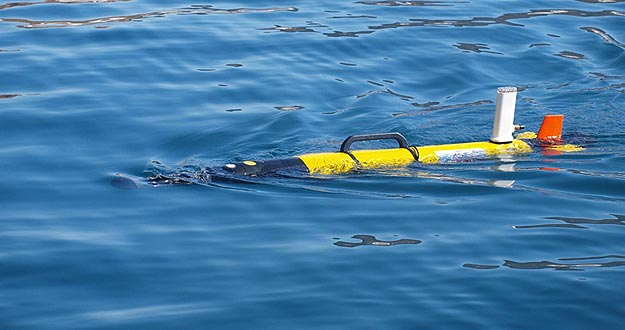
The submarine robot "IVER2 AUV"
The simulation is part of an European project, led by the Polytechnic University of Cartagena (UPCT) (East of Spain), which also involved the universities of Oporto, Zagreb and Cyprus.
The initiative seeks to create a fleet of Autonomous Underwater Vehicles (AUV) and Unmanned Aerial Vehicles (UAVs) and Autonomous Surface Vehicles (USVs), with operational capacity to intervene against an oil spill, in European waters, using robotics technology several vehicles cooperate, as reveals the project website.
"It is about being better prepared for disasters like the one in the Gulf of Mexico, four years ago", said the project coordinator Professor, Underwater Robotics ready for Oil Spills (Robotica submarina preparada para vertidos de petroleo), Javier Gilabert, from the UPCT.
Researchers are, since early this year, working on a protocol for joint action, that will be implemented, in Croatian waters.
In the exercise, to simulate deep discharges rhodamine (a harmless reddish tint) to test sensors and undersea vehicles work capacity and communication between the robots.
"Until now, there was a lack of a tool able to detect oil spill in depth and determine its size and nature. With this type of vehicle this problem shall be settled thanks, among other things, to some sensors on submarines”, says Gilabert.
The mock will also serve to test how various unmanned vehicles complement each other, when locating the focus of submarine fuel spills and transmit information underwater to the buoys and to aircraft, throwing information, to the operational command post, in real time.
Moreover, the waters of Cartagena (Murcia, Eastern Spain) will be the setting for a new mock spill detection, in 2015, with which it will be finalized the protocol and the fleet of autonomous vehicles, that Europe will have to react quickly, to potential disasters as those occurring with the Exxon Valdez and the Prestige, at the time.
Well, I think this project is so interesting, for security.
Until my next post, kind regards,
Luis.
Sponsored by Costaluz Lawyers.
Please click below:

 0
Like
Published at 11:40 AM Comments (0)
0
Like
Published at 11:40 AM Comments (0)
Amaia Montero: A spanish Singer with a lot of words inside
Wednesday, September 17, 2014
Yesterday, I listened, on the radio, an interview to a Spanish singer, that I really like: Amaia Montero.
She has been three years without record a CD and she has just recorded her third one. Its tittle is: “Si Dios quiere, yo tambien” (“If God wants, me too”).
Amaia said she has spent 3 years without recording, because she needed rest and reflect, needed to make an "inner journey".
She also said she has evolved, with this album, --which she thinks is the best of her career alone (because she belonged to the group LA OREJA DE VAN GOGH = THE EAR OF VAN GOGH) some few years ago--.
I like how she thinks, because she says that you have take your life such as it comes, because each one of all of us has a mission in life. Therefore she says “If God wants, me too”, because she is willing to strive to fulfill her mission herself.
She is so glad, with this new work, because she has composed all the songs and she has been helped by a very good Producer from Sweeden, Martin Terefé, in London.
She has presented this new album with the song: “Palabras” (“Words”), through two videos (one of them with the lyrics and the other one is a video-clip, where you can see to Amaia). Well, but I want to show you the video with the lyrics, because I think it is a wonder, very nice, and I should like that you enjoy it. If you want to watch this video, please click below, on the link:
http://www.youtube.com/watch?v=xgB4ZSU201E
Amaia said she was helped by her sister, who is a designer.
Here I bring you the lyrics of this song:
Palabras
Que anuncian las despedidas anticipadas
Que explotan en mil pedazos cuando se callan
Que suben por tu garganta entrecortadas
Que matan
Me pierdo
Pensando en nosotros y juro que no me arrepiento
De haberte entregado la vida
Me queda lo bueno
Te miro y a los ojos y sé que ha llegado el momento...
Y tiemblo
Te marchas
Y no sé me ocurre decir ni una sola palabra
Que acabe con este silencio que ahora me alcanza
Y muero matando
Te beso despacio y te digo que solo el amor ya no basta
Mis años, mi vida, mis noches en siete palabras
Cansada
De no parar de dar vueltas en nuestra cama
Volando en paracaídas por esta casa
Buscando rastros de vida, no queda nada...
Que valga
Me pierdo
Pensando en nosotros y juro que no me arrepiento
De haberte entregado la vida, me queda lo bueno
Te miro a los ojos y sé que ha pasado el momento
Y el ego...
Se marcha
Y no sé me ocurre decir ni una sola palabra
Que acabe con este silencio que ahora me alcanza
Y muero matando
Te beso despacio y te digo que solo el amor ya no basta
Mis años, mi vida, mis noches se acaban
Siempre pensaré que te encontró mi estrella de la buena suerte
No sé como curarme el corazón
Y ahora que está claro que ninguno de los dos fue tan valiente
Me pierdo entre la gente y tu voz...
Se marcha
Y no sé me ocurre decir ni una sola palabra
Que acabe con este silencio que ahora me alcanza
Y muero matando
Te beso despacio y te digo que solo el amor ya no basta
Mis años, mi vida, mis noches en siete palabras
Ohh ohh ohh oh oh oh...
Hoy te marchas y el silencio que entró en mi alma
Solo mira por la ventana para verte llegar
Ya no queda entre nosotros nada,
Se acabaron nuestras palabras
Y el recuerdo que no se marcha
Hoy se quiere quedar...
The lyrics in English:
words
Announcing the early stag
Exploding into a million pieces when silent
Climbing up your throat choppy
which kill.
I get lost
Thinking of us and I swear I do not regret
Of having given life
I still have the good thing
I look at you and your eyes and know that the time has come ...
And I tremble.
You leave
I can not know a single word to say,
To end this silence which now reaches me
And I die killing
I kiss slowly and tell you that only love is not enough
My years, my life, my nights, in seven words.
tired,
Failure to stop spinning in our bed,
Flying parachutes from this house,
Looking for signs of life, there is nothing ...
which is worth.
I get lost
Thinking of us and I swear I do not regret
Of having given you life, I still have the good thing.
I look into your eyes and know that the time has passed
And the ego ...
He leaves
And I do not know a single word to say,
To end this silence which now reaches me
And I die killing
I kiss slowly and tell you that only love is not enough
My years, my life, my nights have just.
I always think that you found my lucky star
I do not know how to heal my heart
And now it is clear that neither was so brave
I get lost in the crowd and your voice ...
He leaves
I do not know a single word to say
To end this silence which now reaches me
And I die killing
I kiss slowly and tell you that only love is not enough
My years, my life, my nights in seven words
Ohh ohh ohh oh oh oh ...
Today you leave and the silence that came into my soul
Just look out the window to see you come
There is not anything between us,
Our words are over
And the memory that will not go away
Today it wants to stay ...
Well, I hope that you have enjoyed with the video-lyrics.
And, today, the album is out for sale. So, I hope that you can buy it.
Until my next post, kind regards,
Luis.
Sponsored by Costaluz Lawyers.
Please click below:

 0
Like
Published at 7:35 PM Comments (0)
0
Like
Published at 7:35 PM Comments (0)
A Classical Spanish guitar, young and traveler
Tuesday, September 16, 2014
Yesterday I heard an interesting interview to a young Spanish guitarist, from La Rioja (Northeast Spain). His name is Pablo Sainz Villegas --although I think that he uses only Pablo Villegas, as an artistic name-- and he is living in New York, since 13 years ago.
Pablo (Paul) has come, these days, to Madrid, to record an album, with the National Orchestra of Spain --under the direction of the Master Juanjo Mena--. They will record 3 Concerts by the Master Joaquín Rodrigo: “Concierto de Aranjuez” ("Concert from Aranjuez"), “Fantasía para un gentil hombre” ("Fantasy for a gentleman") and “Concierto para una fiesta” ("Concert for a party"). It will be the first time those 3 concerts will be recorded with the National Orchestra.
With this project, Paul intends to continue the tradition of the Spanish classical guitar, who started the Masters Andrés Segovia and Narciso Yepes.
Paul says that "The Concert from Aranjuez" is a very special work for him, because when he started to learn playing guitar, when he was 7 years old, to hear this concert gave him a lot of special emotions and he dreamed playing it someday. That day came and he said that it has been a process, in which he has discovered new things. And, as a performer, he is excited to discover the Master Rodrigo´s emotions, among note and note. He says he enjoys entering the emotional process of the Master Rodrigo and inviting, to the public, to participate in this emotional process. He says that it is the magic of Music.
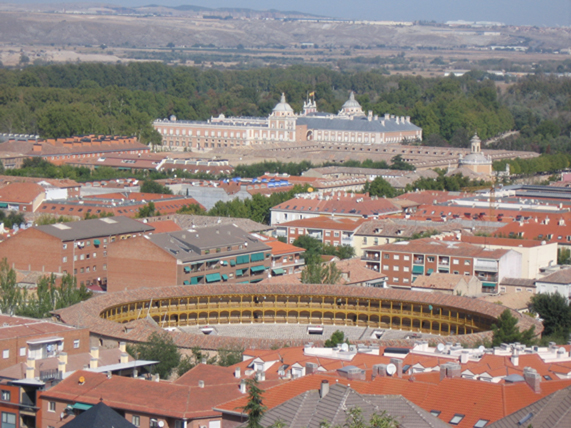
Aranjuez, South of Madrid, Spain
This year, Paul has performed with 7 different orchestras guitar and he said that anywhere he went, everyone liked the guitar, which is a very Spanish symbol.
But Paul has not only interpreted to the Masters like Joaquín Rodrigo and Joaquín Turina, but he has also created their own interpretations, and he has done so through Literature, through a detective novel, "The novel of time, with 10,000 verses", by Juan Ramírez. Paul says it is a wonderful project and Juan invited to Paul to participate in this book, as well as to 8 artists, from La Rioja too.
And Juan Ramírez invited him to compose his first guitar compositions, he (juan) said: "If I, as a writer, have not written poetry and this will be the first time, you, being a musician, I invite you to be a composer, for the first time". Paul says that initially he had a difficult time, for fear of the unknown; but soon he adapted and enjoyed himself.
Paul studied at the Conservatory of Logroño, until age 19, when he went to Berlin with a scholarship, and then went to New York, with another scholarship ..
I want to show you a video-clip, with the “Concert from Aranjuez”, because I love it too. If you want to enjoy it, please click below, on the link:
http://www.youtube.com/watch?v=erwLhFO2f88
Well, I hope that you have enjoyed with this music and with the interpretation by Pablo Villegas.
Untill my next post, kind regards,
Luis.
Sponsored by Costaluz Lawyers.
Please click below:

 0
Like
Published at 1:53 AM Comments (0)
0
Like
Published at 1:53 AM Comments (0)
Another Spanish sayings and proverbs 60
Saturday, September 13, 2014
Today I bring you a very popular saying –although it is still a long time until April--: En Abril, aguas mil = In April, thousand waters.
This proverb expresses what they are normally abundant rainfall in that month. And "because at that time, bread and plants need water", according Covarrubias --Sebastián de Covarrubias studied at Salamanca (1565-1573); he lived there with his uncle-grandfather, the Canon Juan de Covarrubias, in the church of Salamanca. Shortly thereafter, Don Juan resigned in favor of Sebastian, who was a priest. After, he was Felipe II´s chaplain and Canon of the Cathedral of Cuenca. Sebastian was Lexicographer and Writer; he was known, above all, because, in 1611, he wrote a monumental dictionary: "Treasury of the Castilian or Spanish" and it is, in this work, where is the saying that I am showing you today—.
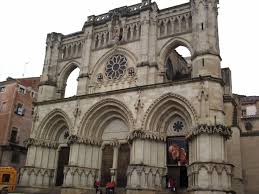
Cathedral of Cuenca
Another similar saying is this one: “Marzo ventoso y Abril lluvioso, sacan a Mayo florid y hermoso” = “Windy March and April showers, bring to May flowery and beautiful”.
Well, I hope that you have liked these sayings, in case of you did not know them.
Until my next post, kind regards,
Luis.
Sponsored by Costaluz Lawyers.
Please click below:

 0
Like
Published at 11:40 AM Comments (0)
0
Like
Published at 11:40 AM Comments (0)
Study to predict ocean currents in the South of Spain
Thursday, September 11, 2014
In order to predict the trajectory of oil and people and objects adrift, in the waters of the Gibraltar Strait, this week CSIC scientists participate in an exercise of launch and tracking of 34 buoys adrift.

Strait of Gibraltar
It is the largest ever number of buoys, used in an exercise of this kind, in Spanish waters, and they are looking to predict the risks of sea currents in the area.
The study by researchers, at the Institute of Marine Sciences (CSIC-MCI), in Barcelona, and the Mediterranean Institute Advanced Studies (CSIC-IMEDEA) allow you to build an operational tool for the early detection and effective seizure control on discharges, into the Mediterranean and resulting oil slicks.
The tool, which will integrate the different prediction models discharges and existing operational ocean-meteorological data bases, will help to better understand the dynamics of these waters and to test the predictive capabilities of existing paths hydrocarbons, objects or people adrift .
During the exercise, with 34 buoys, the teams will observe and manage the information, in real time, and they will perform numerical simulations, with models of oil spills.
In the exercise four boats participate, three units of Maritime Salvage (SASEMAR) and a boat, provided by the Port Authority of Algeciras Bay (APBA), while the IMEDEA participate, the MCI and the State Ports provide oceanographic equipment.
To monitor the path of the different launched buoys and integrate the measured data with other ocean-meteorological informatio n available, it has been established a Monitoring Unit Exercise, as explained by the researchers, Emilio García-Ladona, from the MCI, and Jano Orfila, from the IMEDEA.
The unit, based in the port of Algeciras Bay, during the exercise, is composed of experts from the different participants institutions and connected with scientists from different centres and universities.
The countries benefiting, from this service “MEDESS-4MS”, are Cyprus, Greece, Montenegro, Italy, Malta, France and Spain.
The Strait of Gibraltar is one of the busiest in the world --more than 100,000 ships annually-- and warm in number of search and rescue, at sea point.
Because the density of maritime traffic making the area with the presence of the ports of Algeciras, Tarifa, Ceuta, Tangier Med and Tangier City, and forced most of the sea lanes passage, these waters are exposed to hypothetical spills hydrocarbons, to which must be added that this is an area of high environmental value, including an important extension of protected areas.
CSIC scientists have stressed that the Strait is a region of high interest, for its oceanographic uniqueness, because there the water exchange between the Atlantic and Mediterranean basin occur, generating extremely high current speeds.
Well, I think this is a very interesting project for everybody. I live very near of the Strait of Gibraltar and I like that scientists look forward our area.
Until my next post, kind regards
Luis.
Sponsored by Costaluz Lawyers.
Please click below:

 0
Like
Published at 7:31 PM Comments (0)
0
Like
Published at 7:31 PM Comments (0)
Sir Alfred East in Spain
Wednesday, September 10, 2014
I did not know who was Sir Alfred East; but I read a curious story, about his life, and wanted to share it with you, in case you did not know it.
Alfred East was born in Kettering (Northamptonshire, England) in 1949.
His romantic landscapes show the influence of the "School of Barbizon" (The Barbizon School was a group of French painters, gathered around the village of Barbizon, and were part of French Realism, which emerged in reaction to Romanticism painters more formalistic as Gericault or Delacorix).
In 1892, he visited Spain and stayed in Algeciras (Cádiz, Coast of La Luz), where he produced several charming oils and water colors. Although his pictures show some of Gibraltar, it seems that he never actually visited the Rock.
I am going to show you some pictures painted by East, in Algeciras. These pictures are below:

Sir Alfred East self portrait

Gibraltar from Algeciras (1902)
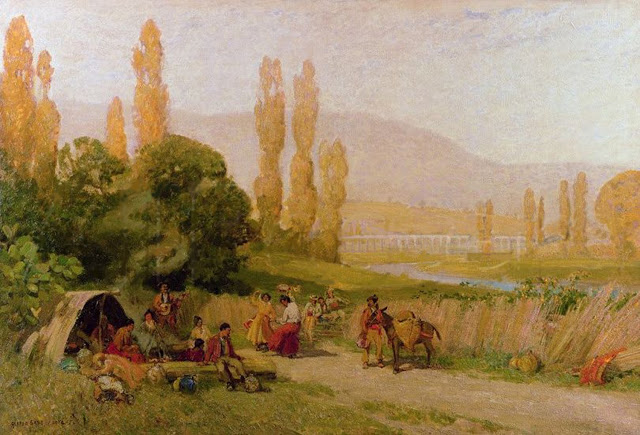
The Arches of El Cobre on the background

The Arches of El Cobre
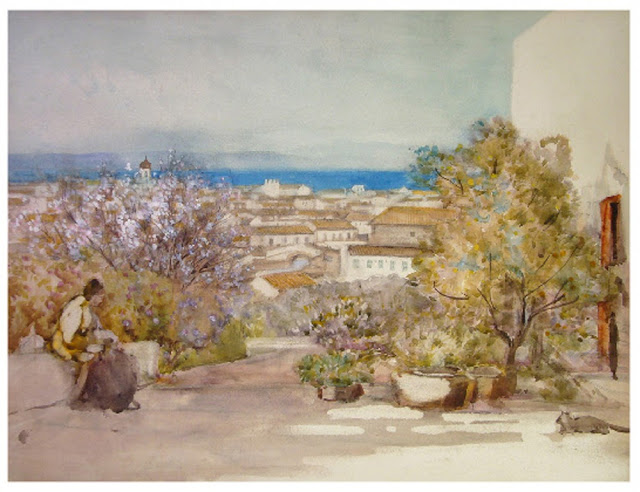
A part of Algeciras
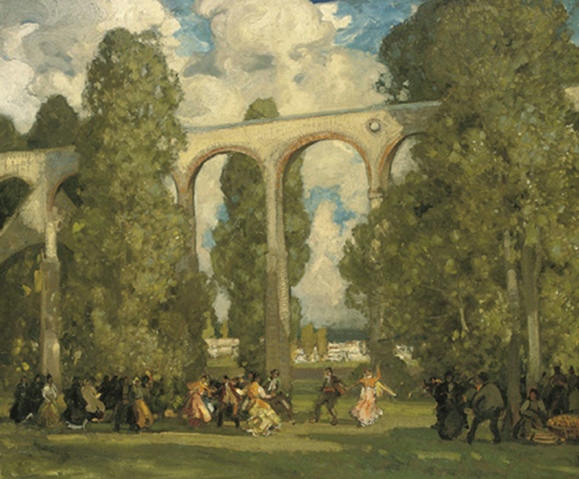
A dance beside the Arches of El Cobre

A country festival
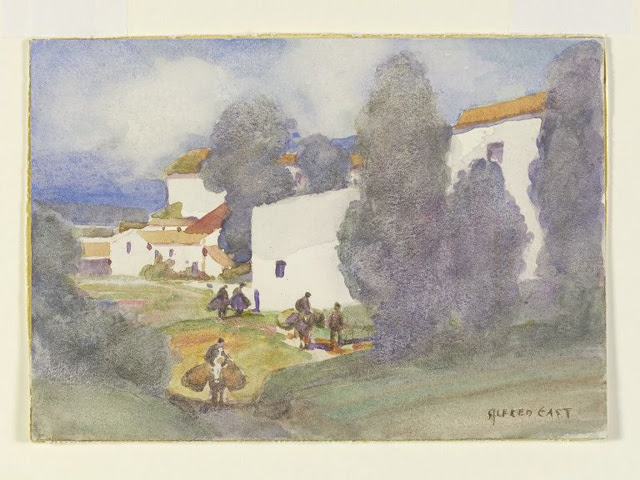
Some houses in countryside
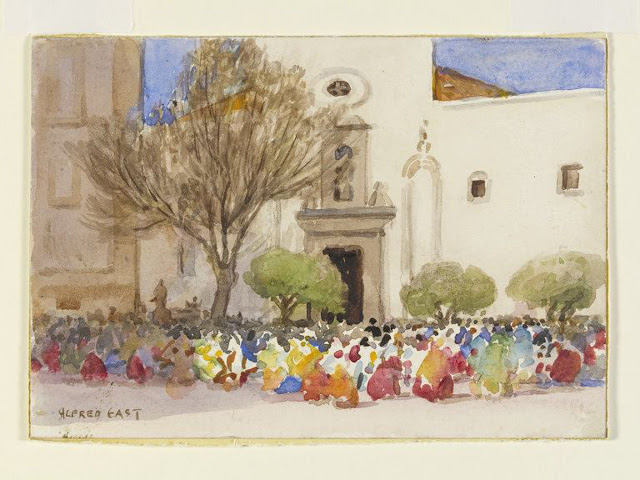
The Church of La Palma, in the Admiral Square or the Square of the Constitution
According to local resident --Ana Rosa Meana Solis--, in the 1900s, the Algeciras Carnival was celebrated from Sunday to Tuesday before Easter. The climax occurred on the following week-end with the "Domingo de Piñata" and the "Baile de Mascaras", which took place in the Plaza del Almirante o Plaza de la Constitución --today's Plaza Alta--, as shown in the picture up.
Well, this has been the news that I wanted to share with you. I hope that you have enjoyed.
Untill my next post, kind regards,
Luis.
Sponsored by Costaluz Lawyers.
Please click below:

 0
Like
Published at 1:34 AM Comments (0)
0
Like
Published at 1:34 AM Comments (0)
The dignity of women in Spain
Tuesday, September 9, 2014
Today I liked reading a news, which said: Monago announces an aid of 300 euros per year to all women over 75 years from Extremadura.
I liked this news, because it is aimed at those women, who lived a part of the history of Spain, recent and very hard: the Civil War and the Postwar.
The news talks about women in Extremadura; but I want to remember all the women in Spain, who have sacrificed their lives, raise their families (husbands, children, grandchildren ....), with nobody did a well-deserved recognition of their efforts and their dignity.
So I am glad with this news: because, at least, a politician has given a true value to Democracy in Spain. This gesture is symbolic --in my opinion--, because I think these women deserve more and I could not set a price on dedication; but, at least, it has been done a fair recognition, accompanied by a small economic aid.
The news said the following:
The President of the Government of Extremadura, José Antonio Monago, announced, yesterday, on Sunday, the launch of a permanent aid of 300 euros, per year, to "all women who lived the Spanish war, in Extremadura, war and postwar and, with effort and sacrifice, they also made our Democracy possible and Extremadura today".
An aid to be paid annually, directly or by deduction, to the 35,000 women, from Extremadura, who are more than 75 years, announced the president of Extremadura.
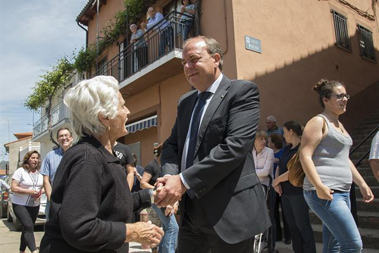
Jose Antonio Monago with a woman from Extremadura
José Antonio Monago made the announcement during his speech, last night, at the official ceremony marking the Day of Extremadura, which took place at the Roman Theatre of Mérida.
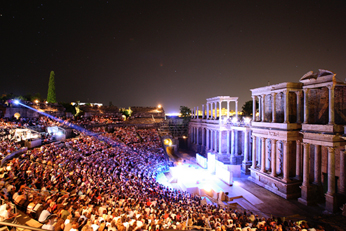
The Roman Theatre of Merida
In his speech, Monago stressed that this aid of 300 Euros, each year --whose announcement was greeted with applause, by those attending the event, for these women "is much more than a symbolic measure", but that "it is a matter of dignity, justice and historical memory".
And is that, as it has been reported, during his speech, "if someone wants to really know who we are as a people, it does not need to read it in books", without or that "you just have to approach your grandmother or mother and ask how her life has been".
It is, in the opinion of the President of Extremadura: "a generation of women who were born, grew up and overcame the war and the Postwar period", a time when "all doors for women were to open, especially in rural Extremadura, in which their work was not recognised”.
In fact, "the vast majority of you could not contribute enough", Monago addressed to these older women, despite all their "wages were 24 hours".
"Your biggest investment, after working as much or more than many men, it was always your family", said the President of Extremadura, who added: "Perhaps you dreamed with an easier life, but you never had it and in spite of it, this effort filled you years of life".
Monago praised these women were "superimposed on all difficulties". "Beside your husbands, you follow supporting your children and grandchildren, and many of you do as well, with half of the pension, when your husbands die", added the President of Extremadura, before announcing this permanent aid of 300 euros, for these women.
Well, I hope that the rest of the women in Spain, can receive this tribute a day.
Until my next post, kind regards,
Luis.
Sponsored by Costaluz Lawyers.
Please click below:

 0
Like
Published at 2:06 AM Comments (0)
0
Like
Published at 2:06 AM Comments (0)
The Bison, come true in Spain
Sunday, September 7, 2014
The “Cueva de Altamira” (Cave of Altamira) is a natural cavity, in the rock, in which one of the most important pictorial and artistic cycles of the Prehistoric is preserved. It is located in Santillana del Mar (Cantabria, Northern Spain).
This cave, declared World Heritage Site, by UNESCO, in 1985, was discovered by a hunter in 1868.
It belongs to the Upper Paleolithic and its paintings and prints belong to the Solutrean and Magdalenian periods. Researchers have shown that this cave was used for more than 35,000 years ago.
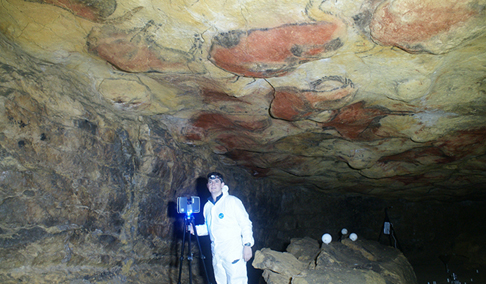
The Main Room in "The cave of Altamira"
The style of much of his work is part of the so-called "Franco-Cantabrian school", characterized by the realism of the figures represented –most of them about animals--.
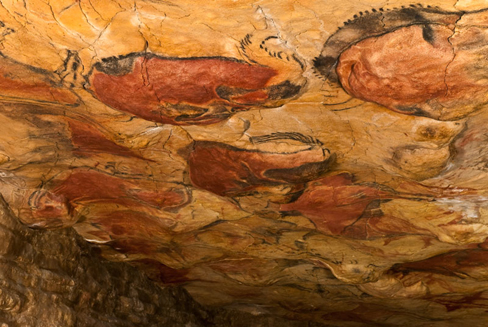
The celling of the Main Room in Altamira
And one of the most represented animals was the Bison:
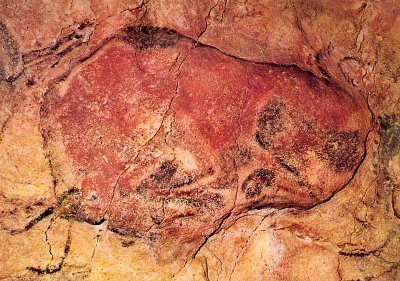
A bison in Altamira
But, Do you think that we can still see some bison in Spain, such as in the paintings of Altamira? ........
Well ...... I thought not; but now I am going to prove to you that it exists --and more than one--, if you want to watch the video, which I will show below. Please click the link:
http://www.rtve.es/alacarta/videos/aqui-la-tierra/aqui-tierra-bisontes-polacos-repueblan-palencia/2741214/
Jesús González (Mayor of San Cebrián de Mudá, Palencia): “Come on, baby, come ..., lovely, come ... come ... great”.
Carla (Voice in off): “This is how Jesus, the Mayor of San Cebrian de Mudá, a small town of Palencia, talks to the bisons, he brought from Poland, 4 years ago”.
Jesús González: “We have lived off the mine, off the coal, for more than 100 years ....; to have cows, there is no cowmen; if there are no cowmen, it was very complicated and ... we decided, then, try to find an animal that, like our deer and our roe deer are grazing, but very little bit, for an animal that could and would replace, an obviously culturally relationship with us. We have Altamira, four steps from here, and that made us, that, in addition, the animal could have a Media pull or…..a pull ..…, that people would come to see it”.
Carla: “And he was right: 15,000 people have already approached the Reserve, to verify that this animal still exists ....”
You can read: Despite its size it can run at 40 km / hour
Carla: “What size has this animal?”
Jesús: “For males reach 2 metros tall and 2 to 3 meters long, and one ton weight”
Carla: “How many kilos of grass can get it to eat?”
Jesus: “One of these animals, which we have seen big, especially male..can be around 30 kilos, every day……What is thrown to them is a sweet for them, let us say, their sweet more delicious .... dowels of alfalfa, dehydrated, with straw, with hay, ... also they have some corn ....”
……music……..
Carla: “Do you notice that they recognize you?”
Jesús: “Well, of course ... I come here every day ... We have 3 years ... of relationship ...., with an almost perfect relationship, in which we do not discuss and, then, evidently, when they hear my voice, they hear: food, food, food, food ....”
……music……….
Jesús: “Right now, they are on alert for anything ... which they are seeing…Do you see how they all put on guard themselves?.They are grouped and placed facing the danger, which they are smelling ....”
You can read: It is not a hostile animal but man has never been able to tame
Jesús: “And if they see danger approaching, they would attack it”
….music…..
Carla: “Accustomed to cold Polish forest, what the European Bison takes worse is the heat ..., the Spanish warm climate has influenced even the date of its births”
Jesus: “Its hair makes that water and snow slide, perfectly, and they have no problem with cold. Normally, now they would have to be giving birth, now in May and June; however, we are seeing the offspring there ... the two offsprings were born in October and November ...; this is a sign that they are comfortable and they do not see a problem, in the Winter”
You can read: The European bison is living in the forests of Lithuania, Ukraine, Russia and Poland
Carla: “In the last 4 years, in San Cebrian de Mudá, 4 bisons were born....; what we are not sure of is that the future generation fit portrayed in a cave”
….music……
Well, here the video is over. I hope that you have liked it. I thougt it was a very curious thing, when I discovered it in Internet.
Until my next post, kind regards,
Luis.
Sponsored by Costaluz Lawyers.
Please click below:

 0
Like
Published at 1:06 AM Comments (0)
0
Like
Published at 1:06 AM Comments (0)
The youth have changed in Spain
Friday, September 5, 2014
I recognise that, until today, I thought that young people were and still are rebels, mavericks and little commitment to Society. But today, after reading a study conducted in Spain about them, I see I was wrong: the youth of today have changed considerably.
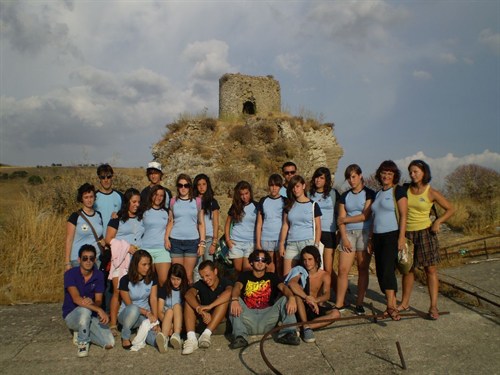
Indeed, the Reina Sofia centre has conducted a study of adolescents and youth deriving main conclusions that "today's youth are more willing to commit to adult society but there is a certain shift towards conservatism between young people, in the sense, they want safer environments, want more seriousness and less fantasy".
This has been explained by Javier Elzo, Professor of Sociology at the University of Deusto and coauthor of the report. "Young people today are also legal, are less adventurous than they could have been before the crisis and governments that want to work", he continued.
The study also shows that between the Spanish youth has increased the legitimacy of the death penalty –some days ago, I listened on tv that the 40 per cent of young people was on right with the death penalty. I feel sorry for that, because I am not on right with death penalty-- . "It is a striking fact", says the professor, who says also: "I bring 40 years doing youth studies and is the first time I see that young people are more institutional than the adult population, this means that even criticizing much to banks, church and politics ..., compared to adults, they put them at best place".
Another fact, that emerges from this report is that "apathetic" youth is quite reduced and that "there is a 20% positive youth leaders, to come and they have been called: "rebels with a cause and a little bit confused".
Finally, Javier Elzo concludes that the poor image of the young cast, in a way, is because of the Mass Media.
Well, I hope that you are glad, with this news, as I do.
Until next time, kind regards,
Luis.
Sponsored by Costaluz Lawyers.
Please click below:

 0
Like
Published at 1:42 AM Comments (0)
0
Like
Published at 1:42 AM Comments (0)
My favorite Spanish painter
Thursday, September 4, 2014
Do you remember that, last February 25, I was at the Sorolla´s House-Musum, in Madrid?. But although I love the Sorolla´s painting and I wanted to take many pictures of his House-Museum, I did not take any picture, in the temporary exhibition, called "Fiesta and color", because there was very little light in the room.
Well, this morning I have had a pleasant surprise: the Director of the National Ballet of Spain, Antonio Najarro, was being interviewed, on the radio, and he was talking about his new show, "Sorolla".
Indeed, in February, we were able to see the art of Sorolla, in his Museum. But now we can also enjoy its light and color differently: through the Spanish Dance and at the Canal Theatre, in Madrid.
The idea, for this show, was born when Antonio Najarro visited the "Vision of Spain", in which there are pictures by Joaquín Sorolla, depicting customs of different areas of the Spain collection.
In the interview, Antonio explained that: "I feel very identified with his painting, by its light, its brightness, its color .... which are traits that I always look for in order to choreograph the Spanish Dance". He has also said: "We also wanted to create a show, in which we could replace much of our folklore, that is much neglected and even obsolete. I wanted to retrieve a vanguard for the public, to see that you can put it on the scene, on a very modern way".
And for that, he went to France in search of Franco Dragone, the Theater Director, who has launched 10 performances of Cirque du Soleil and "It has always struck me his use of color, light and transitions, between act and act, and I wanted beautiful transitions”, said Antonio.
The dancer and choreographer also states that "the public loves our dance, want to know what is happening in our folklore and to foreign audiences to make them to discover that there is more than flamenco, in Spain, it is very satisfying".
So his goal was, from the beginning, "to launch a picture, to present, as a great production, the lesser known dances and especially update".
Antonio says that "Dance gets the viewer into the paintings". He also says that "everything is done with full respect to the bases of the Dance and Folklore". Without realizing it, the audience will move from one region to another one, in Spain, and from alone to very energetic dances group, corals and very intenses. This is the case of the Aragonese Jota or the Basque Aurresku. "It is a very physical show, the dancer ends up exhausted, because they are hard dances; in fact, we have had several injuries, especially physical fatigue", Antonio says.
You can also see Salamancan dances, Catalan Sardana, Bolero, Classical Spanish dance and Flamenco music in live. "They are represented all the people of Spain, tambourine, castanets, with their customs and I love that", says Najarro, who acknowledges that the assembly has done with "maximum respect for tradition, attached to a staging cutting edge, that makes you feel inside a painting by Sorolla".
To pass the light of Sorolla to the Dance, a comprehensive study with Franco Dragone and his team was made. "Both in the ground and in the background there are continuous projections and lighting is totally consistent with these projections".
There is also magic in the locker room, his manager was Nicholas Baudelaire. "He has converted part of the wardrobe, that we had in the ballet, and he created a new one, dyeing fabrics and screen printing on fabric paintings by Sorolla. There are many pieces in which the dancer is totally dressed with Sorolla paintings".
“Sorolla” is supported by the great success,that it achieved, at Matadero Madrid, and you can enjoy it until September-14, at The Theatres at Canal of the capital.
If you want to watch a preview of this show, before going to enjoy it in live or just in case you can not go to Madrid, please click below:
http://www.youtube.com/watch?v=qApd9TVWf7I
Well, I hope that you have liked this post and enjoyed with the piece of the show.
Until next time, kind regards,
Luis.
Sponsored by Costaluz Lawyers.
Please clik below:

 0
Like
Published at 2:16 AM Comments (0)
0
Like
Published at 2:16 AM Comments (0)
My favorite singer in southeastern Spain
Tuesday, September 2, 2014
Today I want to show you a preview of the fourth album, by a singer from Málaga, who I love, Vanesa Martin. If you want to see some of the video clip, please click below:
http://www.rtve.es/alacarta/videos/telediario/vanesa-martin-publica-su-cuarto-disco-momento-madurez-creativa/2734759/
Eva Mora (Voice in off): “To Vanesa Martín, life is a dance of emotions and thus is what she transmits in his latest work, “Crónica de un baile” ("Chronicle of a dance").
Vanesa Martín (Singer and Composer): “All that story on this disc may have happened, perfectly, at a dance: the approach, the nerves, overcoming the risk ..., success ... to get what you want and ... occasionally, farewell ...”
Eva Mora: “At age 6, she was given her first guitar and, since then, she continued to compose. Her other passion is animals and, in particular, dogs; hence, her commitment to the protective”
Vanesa: “In the first videoclip, that I have recorded, “Sin saber por qué” ("Without knowing why"), which is the theme, with that we submit "Chronicle of a dance", I have gotten some dogs, from the protective, for people who watchthe videoclip and feel like ..... those dogs can be adopted”.
Eva Mora: “Vanesa now begins a Tour through Spain and then, will continue to advance through Argentina, Chile and Mexico, convinced that "dance is to live and you have to live to tell it and sing it".
Well, I like the Vanesa style, because she loves dogs and singing and I think that dogs have soul and Vanesa gives soul to her guitar.
I hope that you likes her music, such as I do and I also hope that you can buy her fourth disc “Crónica de un baile”.
Until my next post, kind regards,
Luis.
Sponsored by Costaluz Lawyers.
Please click here below:

 0
Like
Published at 2:56 PM Comments (0)
0
Like
Published at 2:56 PM Comments (0)
Spam post or Abuse? Please let us know
|
|